Georgia Grape Horticultural Areas
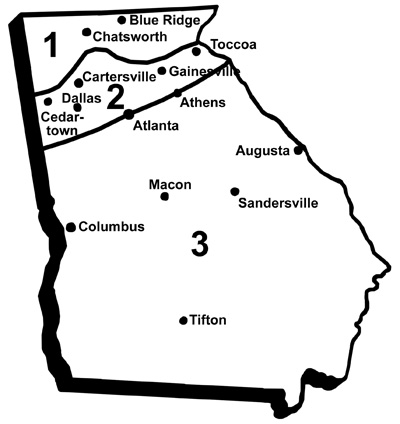
- Mountain Area
- Upper Piedmont Area
- Lower Piedmont, Middle and South Georgia Area
Three primary species of bunch grapes are grown in the United States: the European bunch grape (Vitis vinifera), and two species that collectively we’ll refer to as “American bunch grapes”—the fox grape (Vitis labrusca) and the summer grape (Vitis aestivalis). Bunch grapes are often called “pod grapes” in rural Georgia because they produce large clusters of fruit. Georgia’s climate is not well-suited to home garden production of European bunch grapes, but American bunch grapes and hybrids between the two species (French-American hybrids) potentially can grow well in Georgia. If grapes are well cared for and sprayed with pesticides when diseases and insect threaten, you can expect yields of as high as 20 to 30 lb of fruit per vine.
If you want to grow European bunch grapes, consult www.smallfruits.org for the Bunch Grape IPM Production Guide. This also is a good source for more detailed information on growing hybrid bunch grapes. Because of the high fungal disease and insect pressures found in Georgia, the spray program to produce good quality European bunch grapes (and some hybrid grapes) is intensive and generally impractical for home gardeners.
Pierce’s disease is a bacterial disease spread by leaf-hopper insects that kills susceptible bunch grape varieties. It is very common in middle and South Georgia, and still can be a concern at higher elevations in northern Georgia. Pierce’s disease can be a significant problem in areas of Georgia below 1,300 ft elevation (high mountain area), though disease pressure varies greatly from site to site. Home garden plantings of bunch grapes susceptible to Pierce’s disease generally are feasible above 1,300 ft. Between 700–1,300 ft in elevation, Pierce’s disease will often destroy the vines of susceptible cultivars within 5 years. Below 700 ft elevation, Pierce’s disease often destroys the vineyard within 3 years.
These boundaries can shift with climate variation from year to year. Below 1,300 ft elevation, it is recommended to plant cultivars resistant to Pierce’s disease, but incidence of Pierce’s disease has recently been reported in vineyards planted as high as 1,500 ft in elevation. Grower and researcher evaluation of relative cultivar tolerance/susceptibility to Pierce’s disease is underway in regionally popular hybrid bunch grape varieties.
Best Place to Plant
The site should be in full sun most or all of the day, so beware of overshading from surrounding trees. Well-drained, loamy sand, sandy loam, loam or clay loam soils are best for grape production. Soil pHs of 6.0–7.0 are optimal for bunch grape production. Given the high proportion of acidic soils in Georgia, lime amendments are often needed before planting grapevines. Avoid areas where water stands after heavy rains.
Late spring frosts can significantly reduce yields across Georgia’s Mountain and Piedmont regions, but they can affect southern regions as well. To reduce spring frost risk, it is best to plant grapes on convex rather than concave landforms and on land that is relatively higher in elevation to the surrounding land. This will encourage cold air settling away from vines that have already broken bud.
Rootstocks
American bunch grapes are usually grown on their own roots in North Georgia, but some French-American hybrids, such as ‘Traminette’, can be own-rooted—though they’re often still are grafted for other rootstock-derived benefits. European and hybrid bunch grapes are usually grafted on rootstocks such as SO4 or 3309 to provide increased Phylloxera resistance. On sandy sites (especially in South Georgia), test for the presence of root-knot nematodes. If they are present, grapes should be grafted on nematode-resistant rootstocks such as ‘Tampa’, ‘Florilush’, or ‘Dog Ridge’. Low-vigor varieties, as noted in the tables, are often grafted to improve their vigor. However, some rootstocks—such as ‘Riparia Gloire’ and 101-14—are used to attenuate the inherent vigor of popularly grown European and hybrid bunch grapes.
Varieties
While more trials will be necessary to determine which varieties are most likely to do well in Area 3, many varieties will perform well in Areas 1 and 2.
Most French-American and interspecific hybrid bunch grapes (‘Blanc du bois’, ‘Chambourcin’, ‘Chardonel’, ‘Traminette’) will require more intensive pest management than the American bunch grapes. Tolerance to Pierce’s disease is not known for many of the varieties listed in the tables. Therefore, more trials in Areas 2 and 3 are necessary.
Several hybrid bunch grape varieties have been developed which are worthy of trial plantings in middle and south Georgia. All of these have good tolerance to Pierce’s disease, the primary limiting factor to bunch grape culture in the middle and southern portion of Georgia. Table 1 lists suggested varieties for home plantings.
| Variety | Type | Areas of Georgia | Red Wine | White Wine | Juice Jelly | Fresh Eating | Comments |
|---|---|---|---|---|---|---|---|
| Venus | I | 1 & 2 | X | X | seedless, blue-black fruit; seed traces present | ||
| Interlaken | F | 1 & 2 | X | seedless; suffers cold damage often | |||
| Foch (Kuhlman) | F | 1 | X | blue-black fruit | |||
| Aurora | F | 1 | X | X | good wine; fresh eating | ||
| Jupiter | I | 1 & 2 | X | seedless, blue fruit | |||
| Reliance | I | 1 & 2 | X | seedless, red fruit; fruit cracking problems | |||
| Cascade | F | 1 & 2 | X | X | performed well in Georgia test | ||
| Van Buren | A | 1 | X | X | black fruit | ||
| Alwood | A | 1 & 2 | X | X | blue fruit | ||
| Ontario | A | 1 | X | green to amber fruit | |||
| Fredonia | A | 1 & 2 | X | X | blue fruit | ||
| Baco Noir (Baco #1) | F | 1 & 2 | X | blue-black fruit | |||
| Delaware † | A | 1 & 2 | X | X | X | reddish fruit, small but sweet; good red wine | |
| Chelois | F | 1 & 2 | X | blue-black fruit | |||
| Norton (Cynthiana) | A | 1 & 2 | X | V. aestivalis variety; good quality wine | |||
| Chambourcin | F | 1 & 2 | X | good quality red wine | |||
| Mars | I | 1 & 2 | X | X | seedless, blue fruit | ||
| Saturn | I | 1 & 2 | X | X | seedless, red fruit | ||
| Chancellor | F | 1 & 2 | X | dark red fruit | |||
| Buffalo | A | 1 & 2 | X | X | good yields | ||
| Niagara † | A | 1 & 2 | X | X | golden fruit | ||
| Cayuga White | A | 1 & 2 | X | vigorous vine | |||
| Concord | A | 1 | X | X | X | blue fruit, ripens unevenly; not recommended | |
| Sunbelt | I | 1 & 2 | X | X | Corcord type but ripens more evenly than Concord | ||
| Neptune | I | 1 & 2 | X | X | white seedless | ||
| Portland † | I | 1 & 2 | X | X | amber fruit | ||
| Stuben | A | 1 | X | X | blue fruit | ||
| Agawam | A | 1 | X | X | reddish fruit | ||
| Caco | A | 1 | X | X | reddish fruit | ||
| Champagne | A | 1 & 2 | X | X | reddish fruit | ||
| Catawba † | A | 1 & 2 | X | X | X | purplish red fruit, uneven ripening | |
| Vidal Blanc | F | 1 | X | yellow-green fruit; well-suited for white wine production | |||
| Golden Muscat | F | 1 | X | X | greenish-amber fruit | ||
| Villard Blanc | F | 1 & 2 | X | greenish-yellow fruit | |||
| Seyval Blanc | F | 1 | X | yellow-white fruit that can be used to make white wine; may be susceptible to Pierce’s disease | |||
| Chardonel | I | 1 | X | good variety for making white wine | |||
| Traminette | I | 1 | X | good variety for making white wine | |||
| Blanc du Bois | I | 1 & 2 | X | good variety for white wine; downy mildew control is very important for this variety | |||
| Black Spanish (Lenoir) | I | 1 & 2 | X | dark purple fruit; good potential for red wine production | |||
| Lomanto | I | 1 & 2 | X | early bud break variety with good potential for red wine | |||
|
F/I = French-American or interspecies hybrid; NOTE: hybrids may show varying susceptibility to Pierce’s disease. Some French and interspecific hybrid grapes can have upward-growing shoots and can be grown using a low-trellis design (3 ft); most American grapes have trailing growth and can be grown using a high-trellis design (5 ft). † Should be grafted on 'Dog Ridge' or similar rootstock for best results. There are several Thomas Volney (T.V.) Munson varieties that are good potential bunch grape candidates. A list of these varieties can be found at www.grayson.edu/pathways/viticulture-and-enology/vineyard.html. |
|||||||
| Variety | Red Wine | White Wine | Juice Jelly | Fresh Eating | Comments |
|---|---|---|---|---|---|
| Blanc du Bois | X | X | good white wine; downy mildew control is very important for this variety | ||
| Orlando Seedless | X | small, greenish-yellow fruit | |||
| Suwanee | X | X | good eaten fresh and as wine | ||
| Stover † | X | X | good, golden fruit | ||
| Blue Lake | X | X | purple fruit | ||
| Midsouth | X | sour, purple fruit | |||
| Miss Blue | X | sour, purple fruit | |||
| Conquistador † | X | X | X | very good, similar to Concord | |
| Lake Emerald | X | X | greenish fruit | ||
| Black Spanish (Lenoir) | X | dark purple fruit; good potential for red wine production | |||
| Daytona † | X | low yield but good eating; pink fruit | |||
| † Graft on 'Tampa', 'Lake Emerald', 'Florilush', or 'Dog Ridge' rootstock. There are several Thomas Volney (T.V.) Munson varieties that are good potential bunch grape candidates. A list of these varieties can be found at www.grayson.edu/pathways/viticulture-and-enology/vineyard.html. |
|||||
Purchasing Plants
Bunch grapes, unlike muscadines, do not require cross-pollination, so it is not necessary to buy two or more varieties for pollination. You may, however, want several varieties to extend the fruiting season. For example, white-berried varieties will often be ready to pick well ahead of red-berried varieties. Most bunch grapes are sold as 1-year-old or 2-year-old plants that are either grafted or own-rooted. Generally, the 2-year-old plants grow better and are worth the small extra investment. Be sure to purchase them from a reliable source.
Planting the Vine and Plant Spacing
It is easiest to construct the trellis before planting, but it can be done after planting. Bunch grapes can be planted anywhere from 6 to 8 ft between vines and 9 to 12 ft between rows; equipment use will primarily dictate between-row spacing. Use straight rows for level or slightly rolling land and contour rows for hilly terrain. Prior to setting the vines, soil test and adjust the soil pH to 6.0–7.0 with the appropriate commercial limestone. However, most Georgia soils are low in magnesium, thus the need for dolomitic limestone.
To plant, prepare a hole large enough to accommodate the entire root system in its natural spread. This can be done with an auger or a spade shovel, but be sure to allow the grapes to expand once planted. If vines are grafted onto a rootstock, trim roots back to approximately 12 in. in length before planting. Set the plant to accommodate for settling, and such that the scion buds are 3 to 4 in. above the soil line; this is particularly important for those grapevines that are grafted onto a rootstock. Fill the hole with the natural topsoil and firm it. Do not place fertilizer in the hole. (See section on fertilization.) After firming the soil, water liberally and reduce weed competition, particularly in the first growing season.
Following planting, encourage growth from two to three of the strongest buds. After growth begins, select one or two main trunks from the stronger of these shoots. These will be trained up to the trellis wire that will serve as the fruiting wire. Here, the shoots will be trained out laterally to form the future fruiting cordons.
Trellis Systems and Trellis Construction
Number 9 wire is usually used for grape trellis construction. All posts should be pressure treated or made of termite- and rot-resistant wood such as heart of cedar. Further, the use of steel posts is becoming more popular in vineyards. However, wooden end row structures are usually used in tandem with steel line posts.
American Bunch Grapes
American bunch grapes are vigorous and have a trailing, downward growth habit. However, many hybrid bunch grapes also have a trailing habit and, thus, can be optionally grown on high wire trellising systems as well. Three high trellis systems are commonly used to train home garden American bunch grapes in the south: the double curtain (two wire horizontal system), the two wire vertical and the single wire. The top wire is typically 5 to 5.5 ft above ground level in all three systems.
Double Curtain Trellis — This trellis system can be desirable of the three systems because of increased yields, though will be less ideal in disease-prone areas. The trellis system has two wires 4 ft apart and 5.5 ft above the ground. Figures 1 and 2 show details of how to construct the double curtain trellis. A simple T-bar trellis constructed from treated 4-in. by 4-in. posts can also be used.
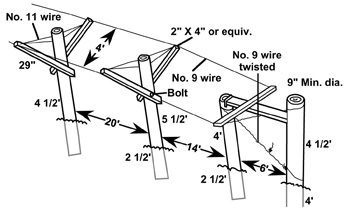
Figure 1. Details for the double curtain trellis.
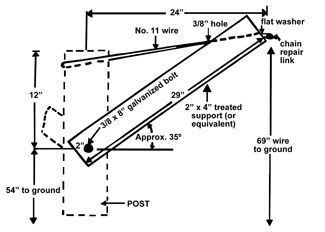
Figure 2. Details of the double curtain support system.
The Two Wire Vertical Trellis — The two wire vertical trellis used for the four-arm Kniffin training system is considerably less expensive to construct than the double curtain trellis. However, shading of the foliage on the lower fruiting canes by the upper canes reduces the quality and productivity of the grapes on the lower wire. Figure 3 illustrates the construction of the two-wire vertical trellis. The primary use for this trellis is in situations where space is limited, but where there is good direct sun exposure. If direct sun exposure is limited, use the double curtain or single wire trellis.
Single Wire High Trellis — This trellis is recommended where diseases are a problem. Since there is only one set of foliage, the vines dry off more rapidly after a rain on the single wire. While yields are lower compared to the other two high wire trellis systems, the single wire system is easier to manage, requires less trellis construction and supplies, and offers the ability to plant rows closer together than the double curtain system. Construct end supports as shown in Figure 3.
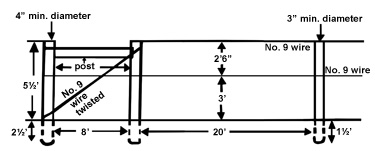
Figure 3. Dimensions of a two-wire vertical trellis (four-arm Kniffin), showing end braces.

Figure 4. Detail for the single wire low trellis with catch wires. This view is looking down the row. Special nails or a bent nail can be used for the catch wire.
French Hybrid and European Bunch Grapes
Single-Wire Low Trellis with Catch Wires (Low Trellis Cordon System) — Most American bunch grapes do not grow upright. However, many hybrid and European bunch grapes have new shoots that naturally grow upward. Two movable catch wires above the cordons (arms) further encourage this growth habit and allow good exposure of the fruit to sunlight and fungicide sprays. The low-trellis cordon system establishes the cordons 3 to 3.5 ft above the ground and, depending on post height, includes two to three movable catch wires positioned at 8 to 10 in. intervals above the cordon wire. This system promotes vertical growth, resulting in a narrow, upright vertical canopy (Figure 4). Thus, looking down the row, the tucked upright shoots look like a consistent hedgerow of foliage that is growing above the low-positioned cordon.
Training Young Vines
First Year — Regardless of the training system to be followed, your goal is the development and establishment of a well developed root system. It is recommended that after planting, the strongest cane be cut back to two or three strong buds. Remove any other canes present. Because it is sometimes difficult to determine the condition of a dormant vine, however, some growers prefer to leave five to six buds and then, when growth starts, only allow the most vigorous or desirable buds to develop into shoots. These shoots will be trained to form trunks and cordons, the permanent woody tissues of a grapevine.
If the trellis cannot be constructed the first growing season, then a stake 4 to 5 ft high should be driven in the soil near each vine and the new growth trained to it. Although bamboo can work, it is often unable to stay erect without the support of a wire. Thus, stakes made of stronger materials, such as steel, may be desirable if a trellis is not constructed at the time of planting. Tie the shoots loosely, or with plastic tape, to avoid the possibility of girdling. In cool areas of the country, growth rates are slow and vines are often pruned back to near ground level the first winter to help develop a vigorous trunk the second year. In Georgia, the growing season is long and vines often make impressive growth the first year. While many may opt for training only one trunk, training two trunks provides insurance in case on trunk is subject to mechanical or cold injury.
Double Curtain Trellis — Develop a double trunk (Y-shape) for each vine approximately 30 in. above the ground. This is done by pinching out the growing point and forcing two lateral shoots to develop. One trunk should be allowed to grow to one of the trellis wires and the other trunk to the other wire. Just below the wire, pinch out the tip of the growing shoots to encourage lateral shoot formation and growth. These lateral shoots will be trained to the catch wires to serve as fruiting cordons. Under good conditions, the trunk system for the grape vine should be developed by the end of the first growing season.
Two-Wire Vertical Trellis — Develop a single strong shoot arising from the young plant by removing competing shoots. Train this shoot to a string or stake running from the upper wire of the trellis to the ground. Just below each wire pinch out the tip to encourage two lateral shoots to develop. These lateral shoots will be used to train the vine horizontally onto the fruiting wire.
Single-Wire Trellis High Trellis and Single Wire Low Trellis with Catch Wires — One shoot should be allowed to develop into the trunk. Train the trunk to a string or a training stake. When the tip reaches the wire, pinch it out and select two shoots growing about 8 in. below the wire. Shoots positioned to grow on the trellis wire should be allowed to grow 12 to 18 in. long before they are tied down to the wires. Never tie the growing shoot tips to the wire because they will lose vigor. Always leave at least 6 in. of shoot tip free beyond the last tie so it can grow in an upward direction to maintain vigor.
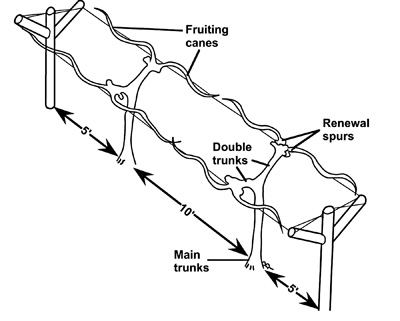
Figure 5. The double curtain trellis showing double trunks, fruiting canes, and renewal spurs after pruning.
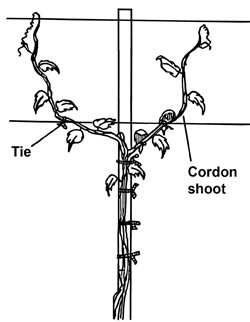
Figure 6. Detail for the single wire low trellis with catch wires. Tie the cordon shoots to the cordon wire only after they are 1.5 to 2 ft long (From S.C. Master Gardener Training Manual).
Second Year — The second year should be devoted to training and developing a strong plant structure that can support some fruiting during the third season. Figure 5 illustrates vines properly trained to the double curtain trellis, while Figure 8 illustrates pruning and training to the two wire vertical trellis (Kniffin system).
Assuming normal growth has been obtained during the first growing season, all buds on the trunk remaining after pruning are capable of developing into shoots and producing fruit. Fruit production at this stage of vine development may reduce vegetative growth and, therefore, is not desirable. Thus, removal of flower clusters is recommended in the second year. Exceptions to this rule is if the vine has grown tremendously the first year; in this case, it may be okay to maintain a cluster per shoot. All shoots below the bottom trellis wire should be removed, including suckers from the base of the vine. Continue to develop the permanent cordons (the lateral growth on the fruiting wire).
Pruning the Bearing Vine
Grapes require annual pruning to maintain quality and productivity. Prune during the dormant season which, depending on the zone in which your vineyard is planted, is from late November through late March. Late winter or spring pruning will cause “bleeding” (flow of sap through the pruning wounds), but this should not cause alarm since it does not damage the plant.
Two Types of Training/Pruning
Two very different types of pruning are used on bunch grapes. While cordon training/spur pruning is by far the most popular training/pruning combination, many vineyard owners also employ head training/cane pruning, particularly in hybrid grapes trained to low trellis systems with vertical shoot positioning. With cane pruning, only the trunk is permanent. The cordons (arms) are formed by leaving several of last year’s canes. With spur pruning, the trunk and the cordons are permanent and the current season’s growth is cut back to short shoots (spurs).
Head Training/Cane Pruning
Do not overcrop third year vines. Thin the fruit clusters to one per shoot. Most mature vines (typically 4 years and older) should be pruned to have between 30 and 60 buds. The more vigorous the vine, the more buds should be left. Balanced pruning, a method of pruning to balance production and vine vigor, is recommended for two wire systems. To balance prune, select four canes of last summer’s growth, one for each direction on the two wires (Figure 7).
One benefit to head training/cane pruning is that most shoots that arise from the retained canes are fruitful, and basal/nonfruitful shoots are minimized, thus minimizing the need for shoot thinning to prevent fruit-zone overcrowding. One drawback to head training/cane pruning is that once the canes that will be retained are selected, they must also be tied down to the fruiting wire. These should be selected from canes arising from the head (the region where the vertical trunk “splits” and is trained horizontally to the fruiting wires) of the vine. Canes about the diameter of a pencil are most desirable. Cut each of these back to leave 15 to 20 buds per cane. Gather up all of last season’s canes pruned from the vine and weigh them. Note: Do not weigh wood that is greater than 1 year old.
As a rule of thumb, 30 buds should be left on the vine for the first pound of prunings removed, and 10 buds for each additional pound. Vines producing less than 0.75 lb of prunings should not be cropped. As an example, suppose a vine (after pruning where 60 buds were left) yielded 3.5 lb of prunings. Then the number of buds to be left would be about 55 (30 for the first pound and 25 for the other 2.5 lb). Each of the four canes left should be pruned back to have about 14 buds each (14 buds x 4 canes = 56 total buds). If balanced pruning is not to be done, then 30 to 60 buds should be left; the greater number being left on the most vigorous vines.
Leave renewal spurs in the head region to form canes for next year (Figure 7). These spurs are also canes of last season’s growth pruned back to leave only two buds each. From these spurs will grow the fruiting canes for next year. Renewal spurs should be located as near the trunk(s) as possible.
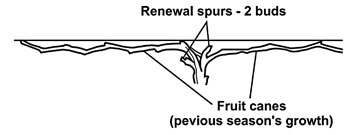
Figure 7. Grape vine properly pruned showing fruiting canes and renewal spurs. Prune each cane on the double curtain or two wire vertical trellis similarly to this
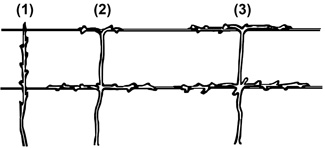
Figure 8. Training the young vine to the two wire vertical trellis (four-arm Kniffin) system. (1) Pruning after 1 year’s growth, (2) after 2 years’ growth, (3) after 3 years’ growth.
Cordon Training/Spur Pruning
Cordon training/spur pruning is more popular than head training/cane pruning, and this is perhaps due to the ease with which it is executed. It is primarily used on high-wire systems such as the double curtain or single high wire. One drawback to cordon training/spur pruning is that diseases can form in the cordons over time. Further, several basal/nonfruitful shoots can grow from the cordon; as a consequence, the fruit-zone can become overcrowded and more susceptible to fungal diseases due to reduced air movement and fungicide coverage on the fruit. This, however, can be mitigated by selective fruit-zone leaf removal (see below).
Single wire low trellis with catch arms — In late winter, cut back the shoots that grew during the previous summer (now dormant, woody canes). This forms the “spurs.” Leave two to three buds per spur for French hybrid grapes and four to six buds on American bunch grapes. Select shoots that grew upward in a well-lighted environment to have the most fruitful spurs. Remove weak shoots.
In the spring, allow four to six shoots per foot of cordon to develop, removing basal shoots (those arising from regions other than the 1-year-old retained spurs) where necessary. Also selectively remove leaves from around the fruit clusters to improve fruit quality and help reduce disease pressure. These leaves can be removed shortly after bloom but before the berries begin to change color and soften. Do not remove leaves after the berries begin to soften because sunburn may result. Thin fruit clusters to no more than two per shoot. As the new shoots become long enough, place them into the catch wires.
Fertilization
Making soil amendments before planting helps get the young vines off to a good start. As mentioned above, soil pH is critical (6.0–6.5 may be ideal for all grapes) to be sure the vine is getting a balanced supply of macronutrients and micronutrients. If the soil is too acidic (i.e., below 5.5), then the supply of major cations (K, Mg, and Ca) can become out of balance. Contact your county Cooperative Extension agent for assistance with testing the soil prior to planting.
After the plants have been settled by a drenching rain and before growth starts, apply 2 oz of 10-10-10 fertilizer around each plant. Keep the fertilizer at least 6 in. from the vine and scatter evenly in a circle 2 ft in diameter. This can be repeated, but use your soil test reports and visual observations to gauge the need for further fertilization. Usually, high soil organic matter equals high soil fertility, and the decreased need for repeated fertilizer applications. Remember: these vines are young and are susceptible to nutrient toxicity and tissue burn due to their relatively low plant tissue biomass.
Further, most newly planted, young vines show some form of mineral nutrient deficiency because their roots are shallow and in soil profile layers that frequently dry out. Deficiency symptoms are often fixed with a good watering in order to solubilize the nutrients to be taken up by the roots. Perhaps even more important than fertilization is reducing weed competition and making sure the young vines receive ample water supply.
On 2-year-old vines, double the first year rate and increase the diameter of the circle to 3 ft. Bearing vines (3 years and older) will need about 2.5 lb of 10-10-10 per plant, and this is best applied around bloom, or flowering. Scatter this evenly under the vines in a band 4 ft wide. Again, use knowledge gained from soil reports as well as visual foliar observations to determine nutrient need. Petiole sampling at bloom is another option to determine vineyard nutrient status, and this can be done annually on commercially mature vines (3 years or older).
Information on proper petiole sampling can be found in Extension bulletins by other universities, and plant tissue nutrient analyses can be performed by the UGA Agricultural and Environmental Services Laboratories. Work with your local Extension agent to process plant tissue samples.
Because Georgia soils are inherently low in magnesium, foliar magnesium deficiency frequently becomes noticeable in mid-summer. This deficiency is characterized by a yellowing between the leaf veins on the older grape leaves. If the soil pH is sufficiently low to warrant liming, use dolomitic lime to help prevent magnesium deficiency in future years; however, liming raises soil pH more effectively when it is incorporated into the soil before planting. Otherwise, magnesium sulfate (Epsom salts) should be applied and watered in to address the magnesium deficiency. It may require 2 to 3 years of magnesium application to bring the level up for the best plant performance.
Cultivation and Weed Control
Make every effort to establish a permanent sod between rows before planting the vineyards to reduce soil erosion. Keep the sod mowed during the summer months. After the sod is established and the vines are planted, hand weeding and hoeing or careful herbicide application will be needed around the individual vines during the first two growing seasons.
Reducing weed competition for soil water and mineral nutrients is imperative for young vines. The use of grow tubes around young vines can offer physical protection from carefully applied herbicides as well as rodents and deer.
Once the vineyard is established and producing fruit (generally the third season), herbicides can be used to keep the vineyard floor under the vine free of weeds and grasses. Several herbicides cleared for use on grapes do an excellent job if properly used. They can be applied with tractor-mounted or hand-operated equipment, but be sure to remove any green suckers emerging from the trunk and ground before herbicide application.
See your county Extension agent for specific weed control recommendations. Mulching is also useful for improving soil temperature and soil moisture and for reducing weed growth.
Insects and Diseases
Since bunch grapes are susceptible to a number of diseases and are attacked by several insect pests, a season-long spray program may be necessary to produce good fruit. UGA Extension publishes a home and garden version of the Georgia Pest Management Handbook, which contains a chapter on disease and insect pest management in the home orchard. You can purchase the printed book from UGA Extension or find the relevant section on their website at the link above.
The publication gives tips for a good spray program along with additional information and precautions. Read and understand the section on precautions first. Pesticides are dangerous when they are misused and mishandled. This and other Extension publications are available at extension.uga.edu/publications.html.
The Southeast Regional Bunch Grape Integrated Management Guide has more specific management timing information for the pests and diseases you may encounter with bunch grapes. The guide is updated annually and can be found at the Southern Region Small Fruit Consortium website (smallfruits.org/ipm-production-guides/).
We acknowledge the authors and prior reviewers of the original manuscript of this publication: Gerard Krewer, former Extension horticulture specialist, and Cain Hickey, former Extension viticulture specialist.
Status and Revision History
Published with Major Revisions on Oct 15, 2006
In Review on Jan 05, 2010
In Review for Minor Revisions on Jan 05, 2010
Published on Jan 28, 2011
Published with Full Review on Jan 01, 2014
Published with Minor Revisions on Jun 13, 2017
Published with Minor Revisions on Aug 23, 2024
